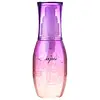What's inside
What's inside
 Key Ingredients
Key Ingredients

No key ingredients
 Benefits
Benefits

 Concerns
Concerns

 Ingredients Side-by-side
Ingredients Side-by-side

Cyclopentasiloxane
EmollientDimethiconol
EmollientDipropylene Glycol
HumectantParfum
MaskingWater
Skin ConditioningArgania Spinosa Kernel Oil
EmollientPolysilicone-18 Cetyl Phosphate
Saccharomyces/Magnesium Ferment
Hydrolyzed Keratin
HumectantKeratin
Skin ConditioningOxidized Keratin
Skin ConditioningPhenoxyethanol
PreservativeSaccharomyces/Iron Ferment
Skin ConditioningSaccharomyces/Zinc Ferment
Skin ConditioningSaccharomyces/Copper Ferment
Skin ConditioningSaccharomyces/Silicon Ferment
Skin ConditioningCyclopentasiloxane, Dimethiconol, Dipropylene Glycol, Parfum, Water, Argania Spinosa Kernel Oil, Polysilicone-18 Cetyl Phosphate, Saccharomyces/Magnesium Ferment, Hydrolyzed Keratin, Keratin, Oxidized Keratin, Phenoxyethanol, Saccharomyces/Iron Ferment, Saccharomyces/Zinc Ferment, Saccharomyces/Copper Ferment, Saccharomyces/Silicon Ferment
Cyclopentasiloxane
EmollientDimethiconol
EmollientDimethicone
EmollientPolyglyceryl-3 Polydimethylsiloxyethyl Dimethicone
Skin ConditioningEthylhexyl Palmitate
EmollientCarboxymethyl Alanyl Disulfide Keratin
Barm Extract
Skin ConditioningAdansonia Digitata Seed Oil
EmollientArgania Spinosa Kernel Oil
EmollientHydrolyzed Keratin Pg-Propyl Methylsilanediol
Skin ConditioningHydrolyzed Keratin
HumectantParaffinum Liquidum
EmollientPPG-4-Ceteth-1
Skin ConditioningLauryl Betaine
CleansingPEG-10 Dimethicone
Skin ConditioningButylene Glycol
HumectantWater
Skin ConditioningAdenosine Phosphate
Skin ConditioningTocopherol
AntioxidantPhenoxyethanol
PreservativeParfum
MaskingCyclopentasiloxane, Dimethiconol, Dimethicone, Polyglyceryl-3 Polydimethylsiloxyethyl Dimethicone, Ethylhexyl Palmitate, Carboxymethyl Alanyl Disulfide Keratin, Barm Extract, Adansonia Digitata Seed Oil, Argania Spinosa Kernel Oil, Hydrolyzed Keratin Pg-Propyl Methylsilanediol, Hydrolyzed Keratin, Paraffinum Liquidum, PPG-4-Ceteth-1, Lauryl Betaine, PEG-10 Dimethicone, Butylene Glycol, Water, Adenosine Phosphate, Tocopherol, Phenoxyethanol, Parfum
Ingredients Explained
These ingredients are found in both products.
Ingredients higher up in an ingredient list are typically present in a larger amount.
You may know this ingredient as argan oil. Argan Oil has antioxidant, hydrating, and soothing properties.
Studies have shown argan oil can help fight again radical damage from the sun. This makes it effective at preventing hyperpigmentation.
Large amounts of vitamin E found in argan oil helps the skin retain water. Argan oil also contains fatty acids such as linoleic acid, oleic acid, and palmitic acid. It is also a good source of lipids.
Another benefit of argan oil is skin-soothing. It can help reduce inflammation-related skin symptoms.
Argan Oil is effective at regulating sebum production in pores. This can make it effective at treating hormonal acne.
Traditionally, argan oil was used for its antibacterial and antifungal properties. However, argan oil contains fatty acids that may make it not fungal-acne safe.
Argan Trees are native to Morocco.
Learn more about Argania Spinosa Kernel OilCyclopentasiloxane, or D5, is a silicone used to improve texture of products and trap moisture.
D5 is considered lightweight and volatile. Volatile means it evaporates quickly after application. Once evaporated, D5 leaves a thin barrier that helps keep skin hydrated.
It is also an emollient. Emollients help soften the skin and prevent water loss. Silicones create a silky texture in products. D5 helps other ingredients become more spreadable.
Studies show D5 is safe to use in skincare products. We recommend speaking with a skincare professional if you have concerns.
Learn more about CyclopentasiloxaneDimethiconol is a silicone that resembles the popular dimethicone. Like other silicones, it is an emollient. Emollients create a thin film on skin to prevent moisture from escaping.
This ingredient helps to create a silky texture and improve spreadability. Due to its high molecular weight and thickness, it is often combined with cyclopentasiloxane.
Hydrolyzed Keratin is derived from keratin. Keratin is a large protein that is naturally found in our hair and skin.
Studies show keratin is able to seal broken hair cuticles, helping to prevent split ends and breakage.
As a humectant, hydrolyzed keratin helps draw moisture from the air to your hair and skin. This helps keep your skin and hair hydrated.
Learn more about Hydrolyzed KeratinParfum is a catch-all term for an ingredient or more that is used to give a scent to products.
Also called "fragrance", this ingredient can be a blend of hundreds of chemicals or plant oils. This means every product with "fragrance" or "parfum" in the ingredients list is a different mixture.
For instance, Habanolide is a proprietary trade name for a specific aroma chemical. When used as a fragrance ingredient in cosmetics, most aroma chemicals fall under the broad labeling category of “FRAGRANCE” or “PARFUM” according to EU and US regulations.
The term 'parfum' or 'fragrance' is not regulated in many countries. In many cases, it is up to the brand to define this term.
For instance, many brands choose to label themselves as "fragrance-free" because they are not using synthetic fragrances. However, their products may still contain ingredients such as essential oils that are considered a fragrance by INCI standards.
One example is Calendula flower extract. Calendula is an essential oil that still imparts a scent or 'fragrance'.
Depending on the blend, the ingredients in the mixture can cause allergies and sensitivities on the skin. Some ingredients that are known EU allergens include linalool and citronellol.
Parfum can also be used to mask or cover an unpleasant scent.
The bottom line is: not all fragrances/parfum/ingredients are created equally. If you are worried about fragrances, we recommend taking a closer look at an ingredient. And of course, we always recommend speaking with a professional.
Learn more about ParfumPhenoxyethanol is a preservative that has germicide, antimicrobial, and aromatic properties. Studies show that phenoxyethanol can prevent microbial growth. By itself, it has a scent that is similar to that of a rose.
It's often used in formulations along with Caprylyl Glycol to preserve the shelf life of products.
Water. It's the most common cosmetic ingredient of all. You'll usually see it at the top of ingredient lists, meaning that it makes up the largest part of the product.
So why is it so popular? Water most often acts as a solvent - this means that it helps dissolve other ingredients into the formulation.
You'll also recognize water as that liquid we all need to stay alive. If you see this, drink a glass of water. Stay hydrated!
Learn more about Water